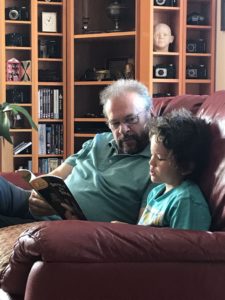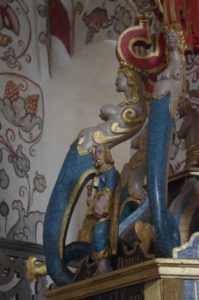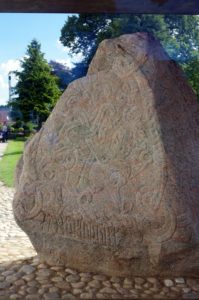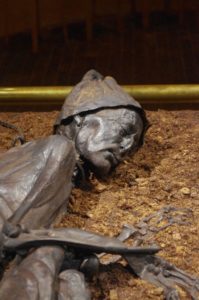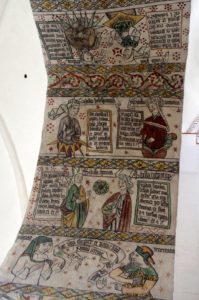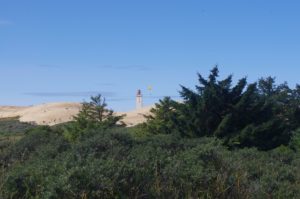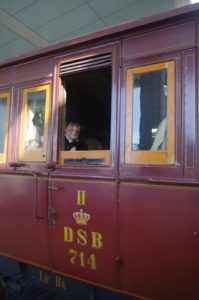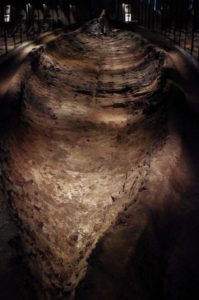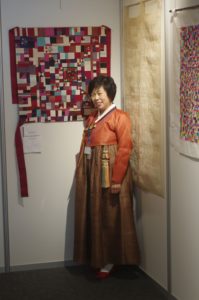To download a printable PDF version (no pictures)
click on this link E2E2017no3.pdf (seven A4 pages)
A link to all the photographs of our Denmark August 2017 trip
A link to the photographs of Carrefour Européen du Patchwork 2017
It all began in July on top of one of the Anglo Saxon burial mounds at Sutton Hoo as we listened to the account of the 1939 excavation of the perfect imprint of the ship and then looked at the site photos taken by a curious holidaymaker and her friend. We have long harboured the idea of revisiting Sweden in quest of runestones, Viking burials and ships. At Sutton Hoo on the mounds above the river, and next morning seeing the huge container ships at Felixstowe and exploring Ipswich, the Viking as well as Anglo Saxon past seemed within our grasp. This year we would set out, – and at least get as far as Denmark.
After that July trip to Letchworth to see the family and tidy the garden and lawn there, we returned to Entre-deux-Eaux to tame the vegetable patch and grass expanses here, pausing en route for lunch with Sue, Ann and Derek in another place redolent of a past age – the Isle of Oxney, once cut off from the mainland of Kent. Alas we no longer needed the services of a ferryman to get us to the Ferry Inn and its car park. Pub grub like lobster and crab linguine and profiteroles may have changed a bit over the centuries, but the Romney Marsh sheep continued to graze, as unmoved by our presence as by that of smugglers in the past.
Back in Entre-deux-Eaux we had five days to hack our way into the potager to gather the first courgettes (which during our absence had turned into eight large marrows worthy of any produce show) and the young broad beans (which are so delicious eaten in their pods) and to pick and freeze the dill, parsley, basil and coriander; and five days in which to clean the farmhouse thoroughly (over winter it tends to turn into an extension of John’s workshop, a greenhouse substitute, and an overflow food store), replace the empty gas canister, eliminate a wasp nest on the inside of a shutter, and make up the beds before Toby, Rachel, Jacob, Farrah and Olivia came to stay for a few days on their way south. John also made a concrete base with embedded tie loops for the swing seat as it had tipped over last time the children played vigorously on it and he suspended the swing from piggy’s apple tree (so called as it’s apples were the favourites of Madame Laine’s pig). But, alas, it seemed pointless to reinflate the swimming pool for them as rain and cool weather were forecast for their stay.
The carload (which included their dog, Teddy) arrived in Toby’s new Discovery Sport around 2.30 in the night and they crept in to their usual beds. The older visitors endeavoured to sleep in next morning after their long drive.
Given the unpleasant change of weather, it was a day for indoor games for Jacob, Farrah and the grandparents and for buying some Wellington boots for Jacob so he could play outside. Jacob soon remembered the blackcurrants and the jelly that can be made with them, so we had a wet foray into the fruit cage (the bushes are taller than Jacob) then he and Grumpy made a blackcurrant jelly. He also admired the height of the broad beans which he and Helen had sown in loo rolls (to protect them when transplanting to the garden) back in Letchworth in April, and we picked more of those and the dwarf beans which had flourished in our absence. A popular indoor visit is always the Confiserie des Hautes Vosges, which gives demonstrations of their sweet making and then leads visitors, overcome by aromatic sugary fumes, up to the sales room with its bags of colourful goodies. An energetic walk along the ridge above Mandray was a good prelude to the sweets. The other must-do local activity is the luge track down to the Col de la Schlucht. This year, given the uncertain weather, we decided to try a metal track for wheeled luges near La Bresse, which was a great success, especially as it had a good play area next to the café which suited adults and children alike. Refreshed we drove along the Route des Cretes to Lac Blanc and scrambled up the steep hills around the lake, led by one enthusiastic small dog and two grubby children. The views were magnificent. The next morning they left at 5 am to drive south to their rented villa near Avignon. Despite all the blocked motorways predicted for this busiest day of the year, by using Waze and following back road detours they reached their villa only a few hours late but in time to collect the key. They had a very hot week there, with plenty of swimming in their villa’s pool, which compensated for the deficiencies of the Entre-deux-Eaux climate, and then they returned to us for a few days. We were able to go to a couple of flea markets on the Sunday and dinner featured John’s new sous-vide machine (for delicious duck fillet), the garden’s marrows, beans (spiced up) then blackberries (in a clafoutis). Toby and Rachel capped this the following night with a meal at the Auberge Frankenbourg, which has remained Toby’s favourite restaurant over the years.
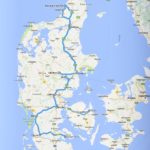 After their departure, our thoughts returned to Denmark, so we drafted a zig-zag car route up Jutland and across to Funen (having realised that Copenhagen and the rest of Zealand and also other islands would have to wait for another journey -perhaps by air) and booked a few hotels. Five days later we discovered how thorough an overhaul the north German motorways are undergoing as we dawdled and queued through road works. But our pleasant overnight stop hotel on the edge of Hamburg made up for all the delays. In the days that followed we were to wish that hotels in Jutland were as tasteful and comfortable with equally magnificent breakfast spreads.
After their departure, our thoughts returned to Denmark, so we drafted a zig-zag car route up Jutland and across to Funen (having realised that Copenhagen and the rest of Zealand and also other islands would have to wait for another journey -perhaps by air) and booked a few hotels. Five days later we discovered how thorough an overhaul the north German motorways are undergoing as we dawdled and queued through road works. But our pleasant overnight stop hotel on the edge of Hamburg made up for all the delays. In the days that followed we were to wish that hotels in Jutland were as tasteful and comfortable with equally magnificent breakfast spreads.
As we edged up the next stretch of German motorway under repair through Holstein towards Schleswig, trying to remember what the Schleswig-Holstein question had been in long ago history lessons, John suggested that once over the border we should detour west to Dybbøl Bank. He had remembered details of the excellent BBC4 Danish drama 1864 (which Helen had completely forgotten) about the Second Schleswig War between Denmark and Prussia which ended in defeat for Denmark at Dybbøl Bank and the loss of a quarter of its territory to Prussia.
It was a glorious day as the sun unexpectedly came out and we found ourselves at the top of a hill with an old windmill and new museum. We walked up to some stones which from a distance could have been runestones, but in fact were the remains of gun emplacements, from which we had an unexpected view over the battle ground to the brilliant blue fjord beyond, which seems less blue in the photos than in memory. The short film at the museum restored Helen’s memory of key events and the political situation.
Our hotel that evening in Tønder was the first of a series of disappointments. In the fifties and sixties Danish design and furniture was so admired, that the garish black and gold bedspread, carpet and chairs in a room opening off a balcony walkway (a bit like a motel) was rather a shock. And the food on offer in town was mainly kebabs or a Chinese buffet (where we ended up).
But next morning the old church in nearby Møgeltønder, approached along a street of lime trees and quaint houses, made up for Tønder’s deficiencies, with its painted walls, ceilings, pews, balconies and even a painted font above which painted mermaids disported provocatively.
Then on to Ribe for its cathedral begun in 1060 and for our first encounter with the Vikings. The Ribe Vikings did not fit the British image of warriors raiding, pillaging and burning monasteries like Lindisfarne. According to the archaeology and reconstructions in the museum they seem to have come up the river to Ribe (from where we never discovered), settled and traded peacefully.
After a wet night in our Kolding hotel under the fourth floor eaves of a once glorious hotel opposite the railway station, we set out to repair our image of Danish design at the Trapholt Museum, where we enjoyed the chair designs, and an exhibition raising the question of whether designs such as the iconic Tripp Trapp high chairs for young children and “ant” chairs of Arne Jacobsen could be copied or imitated by others or whether a T-shirt design showing an emaciated African child carrying a chihuahua and Louis Vuitton bag was permitted to use the bag image. Our original, not imitation, Triptrap chairs have had a useful life well beyond the babyhood of Toby and Leila, who insisted on using them throughout their teenage years (they must be sturdy designs) and visiting children have used them ever since in both Entre-deux-Eaux and Letchworth. Then we drove up the motorway and branched off through gently rolling fields of grain and stubble to the tiny village of Jelling with its little white church dating from 1100, its runestones and its imposing burial mounds.
The two famous runestones stand by the church doorway, one commemorating King Gorm, and the other celebrating Harald Bluetooth’s unification of Denmark and introduction of Christianity. There were some attractive twelfth century frescoes at the east end of the simple church and an organist playing a jumpy little tune and trills at the west end. Outside, the church and mounds were enclosed by traces of the enormous ship shape once marked out by stones and surrounded by an even bigger palisade whose course is now indicated by white pillars. The museum had a very imaginative display to entice children to learn about the small objects found, the life and death of Vikings and the growth of Christianity after Harald Bluetooth’s adoption of it.
Next morning we drove from Ry through Jutland’s Lake District, failing to spot their famous Himmelbjerget, which, at 147 metres, is considerably lower than Entre-deux-Eaux (about 420m above sea level), to Silkeborg.
Silkeborg Museum’s iron age display is fairly basic, and it was sad to discover that when the famous Tollund Man was discovered in a bog in 1950, they did not know how to preserve whole bodies, so after investigations only the head was preserved and what we could see was reconstructed from fragments which had survived the lack of treatment. The bottom part of their other bog body, Elling Woman, had not been kept either as she had been assumed to be an animal before her belt was discovered. However, at the magnificent modern Moesgaard Museum outside Aarhus the next day we gazed with awe at the body of Grauballe Man and watched a fascinating film about its discovery, publicity and exhibition before its conservation by a method which no one else had tried.
In fact we spent a whole day in the museum, enjoying a special exhibition on the Life of the Dead and the sections on barrows, bog offerings and the beautiful silver Gundestrup bowl with its mythological figures (how did it get from Thrace into a Danish bog?) The Viking section was very popular with children and young adults with lots of dramatic reconstructions, sound effects, buttons to push and headphones to don, but less interesting for those who like traditional printed information.
Another good discovery was Aarhus Street Food in a converted bus station garage, where we ate at the Thai Tuk Tuk stall two nights running. When we explored the town (between the two Tuk Tuk meals) we particularly enjoyed the Cathedral; we slipped in between Saturday’s wedding ceremonies, and to the soaring sounds of a singer testing the acoustics before the next wedding and the scampering of excited bridesmaids we gazed at the varied and beautiful uncovered frescoes. We walked around the AroS art museum with its much heralded rainbow glass circular skywalk, but were too footsore after our city wanderings and enjoyment of the street sculptures (especially the pigs suckling outside Arne Jacobsen’s Town Hall and the wind-blown “Snake” in a park) to contemplate the contemporary art works within the museum.
We spent our next day in the rain at the delightful Lindholm Høje Museum and Viking burial ground north of Aalborg. The modern concrete building (donated by the Aalborg Portland cement factory) had an intimate feel, as we sipped warming coffees and watched people coming in from the rain to its little restaurant for a celebratory family Sunday lunch. There was an excellent display of Viking finds in the upper part of the museum and of iron age finds and bogs in the lower part. By the time we had seen it all and found the gift shop irresistible, the rolling rain clouds were clearing and in bursts of sunshine we headed outside and up through the trees to the crest of the south facing burial site. Below us spread the graves, at the top mainly triangles and ovals of stones with a larger stone in the centre and lower down stones forming the ship shapes around cremations. Apart from us and the sheep, the site was almost deserted and very atmospheric as we wandered freely between the throng of almost 700 stone shapes, which had been preserved from subsequent clearing and ploughing by a cover of shifting sand.
It must have been the mention of sand, but the next day we decided to include the west coast sands and sea in our itinerary and made for the once hippy resort of Løkken. We got distracted en route by a cloister and a black wooden windmill from which we spotted a distant lighthouse. Was this the Rubjerg Knude lighthouse we’d read about that was disappearing into the drifting sand and would probably be claimed by the sea coastal erosion in a decade or so? A track led for a kilometre from a busy car park towards the lighthouse, above which colourful paragliders were looping and soaring. Children were sliding down the dunes while adults built cairns and formed words with the rectangular yellowish bricks from the demolished coastguard cottages around the lighthouse. How typical of the Lego-creating Danes! (Anywhere else the bricks would have been cleared away from such a popular tourist place on health and safety grounds). All thoughts of going down to the sea vanished as we saw the jagged cliff face and sheer drops and heard the waves crashing below. Instead we went on to Løkken, where, after coffee, Helen paddled on the sandy beach while John examined the fishing boats and jetty. From there it seemed a long drive south and east across the bridge to the island of Funen and the outskirts of Odense.
A twenty-four hour museum pass enabled us to see plenty of Odense besides Hans Christian Andersen. So we saw the Holy King Canute’s cathedral, the tiny childhood home of HCA, the Brandts Art Gallery with its exhibition of Wilhelm Lundstrøm’s cubist/expressionist works, and the HCA museum. At the latter it was interesting to learn about his great unreciprocated loves, his travels and friendships. It sounded as if he might have been a very tiresome friend and long-staying guest despite his stories and paper cuts (Charles Dickens clearly found him a burden and his “best” friend would never let him use the friendly “du” form of address, which hurt HCA). The Møntergården history museum had artefacts from the times of the Vikings and Canute and the monks right up to the German occupation in WW2.
But we had not escaped from Hans Christian Andersen, as outside a performance group capered round the statue of the Steadfast Tin Soldier and even the excellent Railway Museum started with a section on HCA and trains. HCA was an enthusiastic rail traveller, preferring second class where smoking was not allowed, unlike third class, but he lamented the fact that there were no toilets in the first trains; once in desperation he got out when the train was stationary only to have an express train hurtle past as he flattened himself against his carriage. We had our best meal of the trip in Odense at Kok & Vin (John having finally recovered his taste after a heavy cold).
Our last Vikings were at Ladby where (given the Sutton Hoo inspiration) the excavated Viking ship burial should have been the high point of our visit. But there was so little information about the excavation, finds and theories that we both found it disappointing compared with Lindholm Hoje. The volunteers who built the replica ship which was moored below the burial mound had probably had more fun than the archaeologists.
Back in Entre-deux-Eaux more wet weather awaited our next visitors, Ann and Derek. The annual International Patchwork meeting in Sainte Marie-aux-Mines and surrounding villages in mid-September is always worth visiting. The four of us dashed under hoods and umbrellas between churches, mansions and community centres to see the flamboyant displays. This year there were Barbar elephants in one village church, interesting English patchworkers in a community room, Vietnamese fabrics and Egyptian Tentmakers’ quilts in an exhibition hall, delicate Swiss and Australian contemporary creations in the library/former tobacco manufacturer’s mansion, traditional American quilts in the theatre, Ian Berry’s denim pictures in another exhibition hall and Amish quilts in the Lutheran Eglise en Chaines. We shook our umbrellas outside the “Rest of the World” (which seemed to be just Georgia) exhibition in the Saint Nicolas Presbytery where we warmed up with the Presbytery ladies’ hot chocolate and sampled their home-made fruit tarts.
We each had our favourite display, and Helen’s was the traditional Korean quilts or Bojagis which shared a hall with Belgian and German patchworkers and Polynesian Tifaifai. The Bojagis’ crisp colours and clean lines were eye-catching, as were their exquisitely dressed guardians.
As well as rain there were strong winds to contend with when we drove through the hills for lunch at Chez Guth in Steig (Alsace) after a stormy night. The sky was clear enough to see the superb views on the way, but we had to wait for the last branches of a tree to be removed after it had blown down across the narrow road which snakes down to the village. The hills had vanished under rain clouds several hours later when we left, replete. Our journey to lunch at L’Imprimerie in the book village was less menaced, but we arrived at the restaurant bearing large piles of books. At the Lotus Bleu, a second-hand bookshop a few doors away from the restaurant, John had spotted a selection of English books, among them some of the Folio Society’s handsome bindings. At five euros for three books, we couldn’t resist scooping up a few well-illustrated Shakespeare plays including a 1953 As You Like It illustrated by Salvador Dali, as well as the Iliad and Odyssey illustrated by Elisabeth Frink and Ann and Derek were happy to find a Royal Horticultural Society gardening tome (which they fitted in their luggage despite its considerable weight).
The other annual event we went to with Ann and Derek was Saint Die’s Braderie which takes over many of the streets in the centre with stalls selling everything you can think of from fashion to hardware and food. Most popular was the fast talking vendor of chocolates: you pay 10 euros for a yellow plastic bag and he and his assistant dash round talking and stuffing it with what might seem at the time to be a bargain selection of confectionery. From there we went on to a village flea market in Biffontaine, where, a few minutes after Ann and Derek had invested a euro in a children’s game with English instructions, the heavens opened and everyone packed up their stalls. We retreated into the village hall and sat over portions of French fries and ketchup or mayonnaise till the rain cleared.
You will gather how wet their stay was from the fact that we completed a thousand piece jigsaw of London pubs while they were here, though one day was clear enough for them to walk round the lake at Gerardmer, and we rounded off in style on their last day, strolling through the quaint streets and shops of Kaysersberg and lunching at Aux Armes de France in the wine growing village of Ammerschwihr before driving down to Basel Airport.
Of course, the sun came out a few days after they left, marking the official start of Autumn after the wet summer. The local villagers embarked on autumn activities. In Entre-deux-Eaux the oldies held their beginning-of-term lunch which we both joined. Some local musicians with traditional plucked instruments entertained diners (though were largely ignored by our long table) and were rewarded with birthday cake. And in Sainte Marguerite the Active Brains group of pensioners met and argued their way through brain teasers (Helen did badly on words describing animal noises and sayings involving dogs – we didn’t learn those at school).
Yesterday, on the last day of International Geography Festival in Saint Die, the sun was disguised by an autumnal morning mist in Entre-deux-Eaux, from which the muffled cries of huntsmen could be heard. Perhaps it was appropriate, as this year the Geographers’ theme was the relationship between man and animals. With South Africa as the invited country, there were giraffes in sunglasses on the posters and statues of rhinos and a stuffed crocodile round the base of Tower of Liberty. But as the sun emerged, and the pavement cafes of Saint Die filled up, the Entre-deux-Eaux huntsmen probably didn’t catch anything quite as exotic.
Click on this image to go to the
photographs of our Denmark August 2017 trip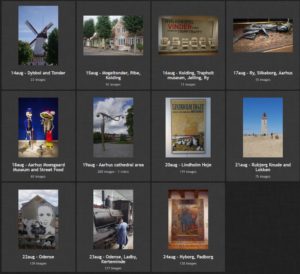
And this link to go to photographs of Carrefour Européen du Patchwork 2017

